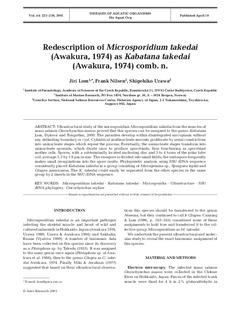| dc.description.abstract | Ultrastructural study of the microsporidian Microsporidium takedai from the muscles of masu salmon Oncorhynchus masou proved that this species can be assigned to the genus Kabatana Lom, Dykova and Tonguthai, 2000. The parasites develop within disintegrated sarcoplasm without any delimiting boundary or cyst. Cylindrical multinucleate meronts proliferate by serial constrictions into uninucleate stages which repeat the process. Eventually, the uninucleate stages transform into uninucleate sporonts, which divide once to produce sporoblasts, thus functioning as sporoblast mother cells. Spores, with a subterminally located anchoring disc and 3 to 4 turns of the polar tube coil, average 3.3 by 1.9 mum in size. The exospore is divided into small fields; the endospore frequently makes small invaginations into the spore inside. Phylogenetic analysis using SSU rDNA sequence consistently placed Kabatana takedai in a group consisting of Microgemma sp., Spraguea lophii and Glugea americanus. The K, takedai could easily be separated from the other species in the same group by 2 inserts in the SSU rDNA sequence. | en |
